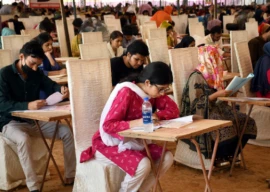
In a small room in People’s Colony, Attock, eight Afghan girls huddle together, giggling. Holding embroidery frames, they copy and stitch floral patterns onto khaddar as Shazia Bukhari, their teacher for two years now, tells them to.
This hour-long activity after school helps these girls earn and contribute financially towards their families. If not for this, they would have had to drop out and find full-time work, weaving carpets up to twelve hours a day.
Another 16 girls embroider at a classroom in a school at Darul Salam Colony under the supervision of another teacher, Farah.
Established by Saba Gul in 2009, these classes were initiated to keep teenaged Afghan girls in school. While a student at Massachusetts Institute of Technology (MIT) in the US, Saba learnt about the rising number of Afghan girls dropping out of school. By October that year, she used an eight-thousand dollar grant from the MIT to establish two workstations with a room each in two different schools. Thirty-eight girls between the ages of 14 and 21 years were enrolled and four teachers were hired at Rs1,500 each.
At 3pm, the girls come for an hour and work on the patterns their supervisors have outlined before their arrival. After 4pm, they are free to go home but some stay back to seek help with school homework.
Shazia says most girls she supervises are from Kabul while some Hazaras are from Mazar-e-Sharif, Jalalabad and Akhja in Afghanistan. Their numbers often fluctuate as their families are very poor and live in squatter colonies, which are constantly moving as a result of land acquisition issues. “So the total number of girls has fallen to 26. It further drops in summers as most families prefer visiting their hometowns,” Shazia says.
“Grandmothers, mothers, aunts, so many of these poor women have come to us since we started,” Saba told The Express Tribune, “but it is not possible to take everyone in due to meagre funds.”
Having run out of the initial grant, she raised some money with help from family and friends and now pays each girl and teacher Rs1,500 a month. But five people working in Lahore, including a designer and a skilled craftsman, have not been paid so far as no revenue has been generated.
Saba returned to Lahore a few months ago and earnestly took up the production phase. “It was hard finding the right person to design bags. Incorporating sequence and stitching embroidered fabric with pure leather also requires highly-skilled labour,” she says. Production expedited in early 2011 after designer Marium Tahir Khan and a factory owner agreed to work with her.
So far, 80 to 100 handbags and clutches have been prepared. Frescos of Multan’s ceramic pottery and Kashmir’s livestock patterns are reminiscent in most pieces. Ajrak and motifs of traditional Afghan carpets are also eminent.
“Designs and patterns are inspired from pottery and fabric prints from all over Pakistan,” Marium said. “Saba and I plan to take our product abroad after exhibiting in Lahore and Karachi.” Being Afghan herself, Marium also plans to visit workstations in Attock to personally supervise girls in new stitching techniques.
The brand is called Sozankaar Collection, meaning skills with needles in Dari. Bags will be displayed at The Second Floor, Karachi, on May 13 and 14, and at Mezzonet, Lahore, on May 28 and 29. They are priced between Rs4,000 and Rs9,000 and revenue will be used to fund the schools and hiring more girls for workstations.
Abdul Rahman, director for schools and Sozankaar project manager, hopes the project will help stabilise the number of girls opting to drop out. Most girls drop out in the sixth or eighth grade as their families pressure them into weaving carpets 12 to 14 hours a day. “I hope this one, small initiative will keep girls from quitting school,” Rahman says.
Published in The Express Tribune, May 12th, 2011.



1719319701-0/BeFunky-collage-(10)1719319701-0-165x106.webp)




1735126617-0/Untitled-design-(67)1735126617-0-270x192.webp)


1735025557-0/Untitled-(96)1735025557-0-270x192.webp)











COMMENTS (2)
Comments are moderated and generally will be posted if they are on-topic and not abusive.
For more information, please see our Comments FAQ